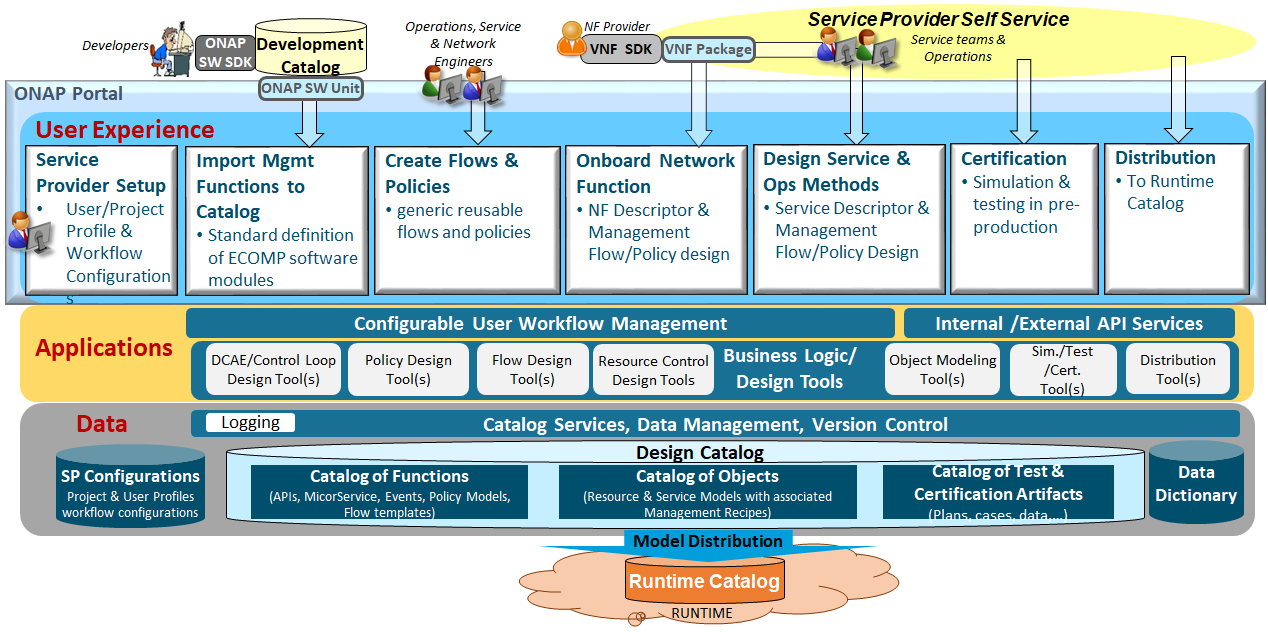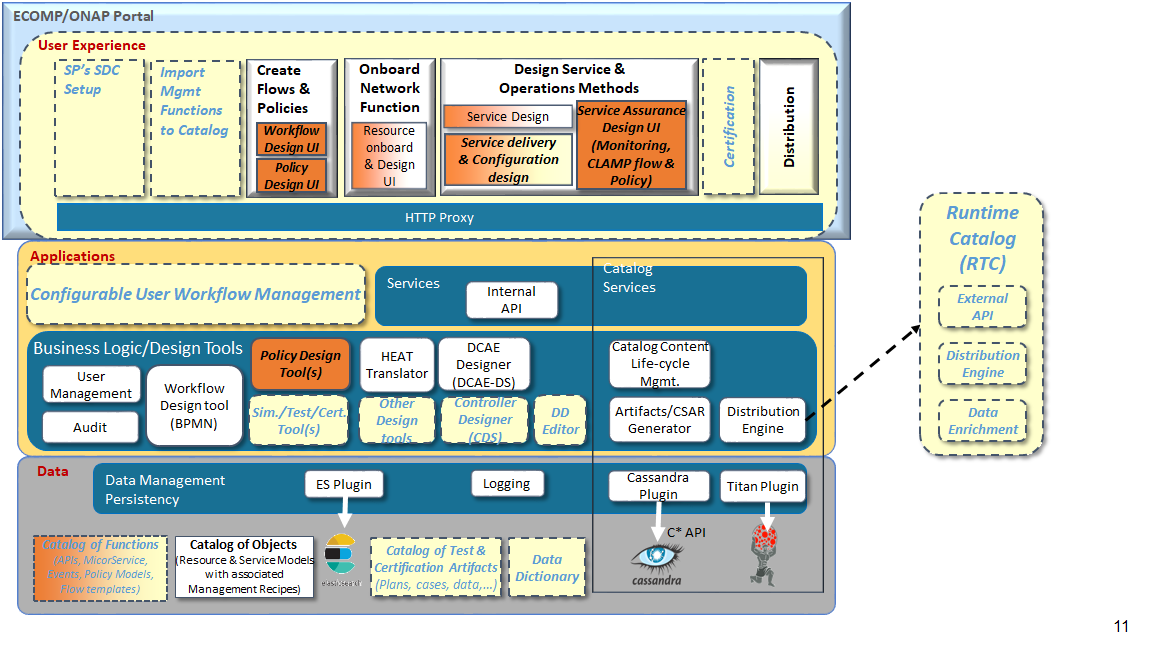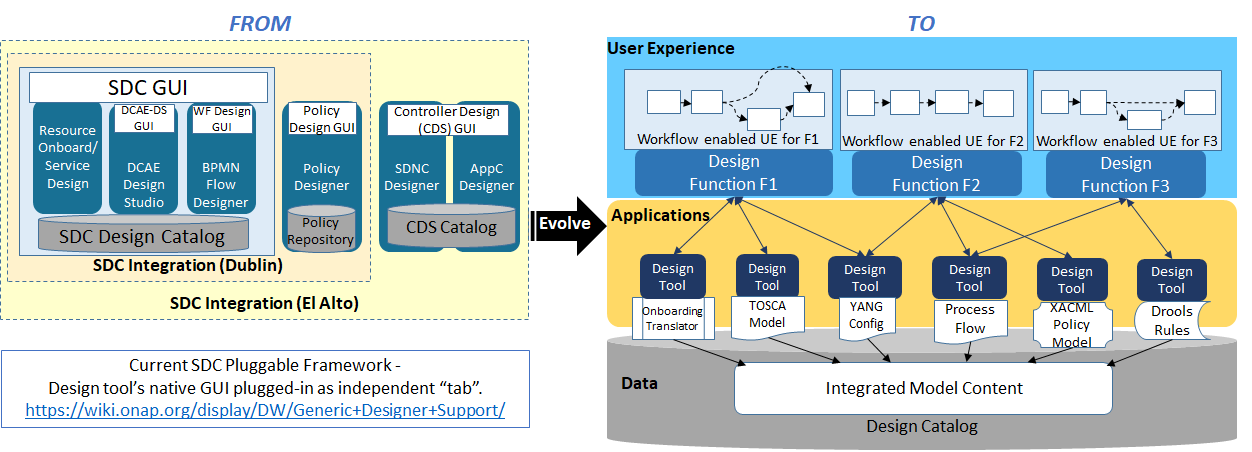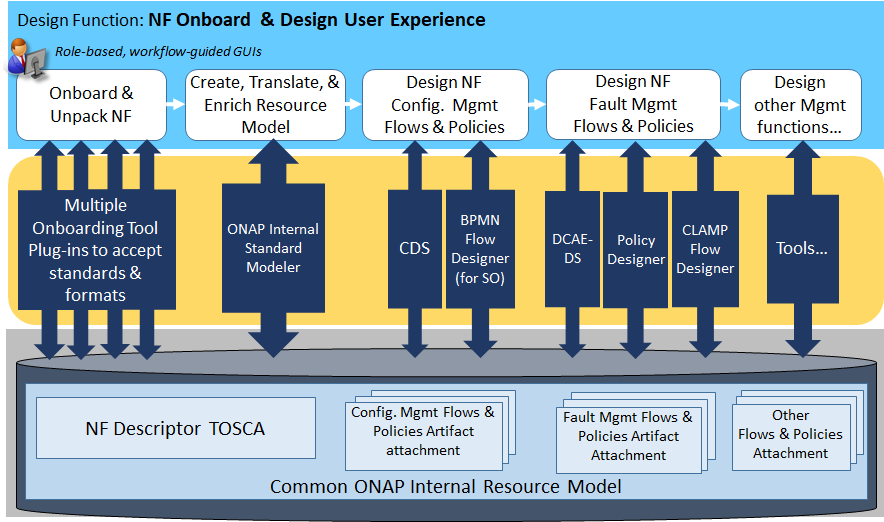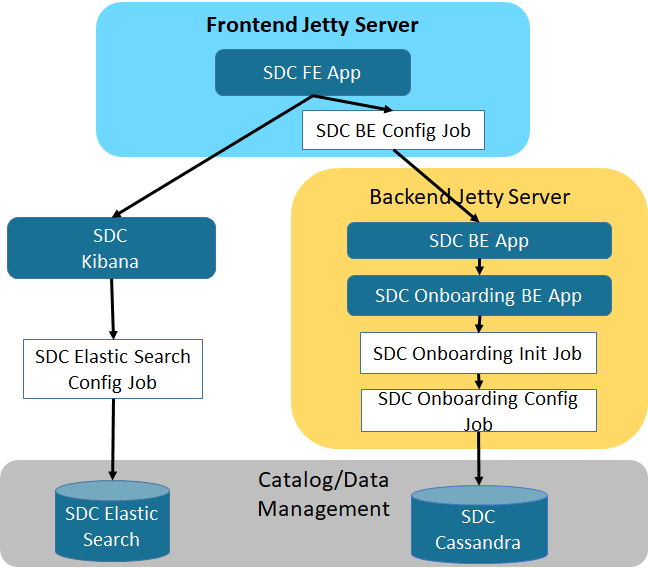This is a working wiki to capture the ONAP architecture component descriptions
Service Design and Creation:
1 SDC High Level Component Definition and Architecteral Relationships
2. SDC Component Description:
SDC is the Centralized ONAP Design Time Platform
- SDC Provides Service Provider a seamless design time user experience
- Allow SP to configure for its design environment including user roles and design workflows
- Import generic ONAP management functions (MS, Flows, Policies) from ONAP developed software and SP’s adaptations (1) (2)
- Onboard & Design resource level network functions (VNF, PNF) (3)
- Compose Service models with resources (4)
- Design Service Provider specific Management Flows and Policies for the Resource or Service Model (5)
- SDC integrates multi design tools into one platform
- Provide ONAP development a “Pluggable framework” for easy design tools integration
- SDC Provides a common Catalog for designed objects
- Support robust catalog cataloging capabilities for storage and management of ONAP standard compliant data models
- Provide linkage & management of SP’s Test/validation process & artifacts for certification of the designed models (6)
- Distributes models to runtime for execution (7)
3 SDC Target Functional Architecture
SDC provides 3 functionally distinct layers with modular software, integrated with internal APIs
4. SDC Current Release API definitions
SDC provides the following interfaces:
| Interface Name | Interface DefinitionD |
|---|---|
| SDCE-1 | VNF is on-boarded thru VNF Onboarding GUI |
| SDCI-1 | VNF is stored in Design CatalogVNF is stored in Design Catalo |
| SDCE-2SDC | Service designer creates a service model from Design Catalog items |
| SDCI-2 | Designer Studio stores and retrieves Design Catalog items |
| SDCE-3 | Ops designer creates monitoring templates with mS data flows |
| SDCI-3 | DCAE Designer Studio stores and retrieves monitoring flow with mS elements |
| SDCE-4 | Service tester certifies service models for distribution |
| SDCE-5 | Service tester distributes service models |
| SDCE-6 | Distribution Engine publishes service notification to DMaaP. ONAP components subscribe to service notification from DMaaP |
| SDCE-7 | ONAP components retrieve service models from the Design Catalog |
Note: xxxI interface is a SDC internal interface. xxxxE interface is a SDCE external interface
The current API documents can be found at:
- https://onap.readthedocs.io/en/latest/submodules/sdc.git/docs/consumedapis.html
- https://onap.readthedocs.io/en/latest/submodules/sdc.git/docs/offeredapis.html
5. Dublin Functional View
The SDC dublin view is:
6 SDC Architecture Evolution (optional item)
The goals of the SDC evolution are:
- Seamless Design Time user experience based on user’s roles and design workflow
- Pluggable Framework to integrate multiple external developed design tools into SDC
- One consolidated Design Catalog with common models in SDC to drive ONAP runtime
6 SDC Overall ONAP Architecture Principle Compliance
7 The SDC near term focus on architecture deficincies are (optional):
User experience:
- Workflow Congfigurator to define service provide specific design workflow
- Workflow guided, role-based user experience
- Function-based (rather than tool based) GUI
Application Layer for Tool Plug-ins
- Provide Plug-in Framework for design tools
- Support standard-based VNF package onboarding tool plug-ins
- Provide Data Mapping/Translation/Enrichment to ONAP Standard Internal Model
- Provide tools to support Service Provider's test & validation environment/process for model certification
- Nert term tasks: Integrate Policy Designer, CLAMP designer, CDS
Catalogue & Data Management
- Support common data model as defined by the modelling team
- Model Data Lifecycle Management
- Runtime Distribution Version Management
8 SDC - Current System Deployment Architecture
User Experience layer (Frontend Jetty Server)
- supplies the static content of web pages, and all resources that required by the GUI
- serves as a proxy for the REST API requests coming from the GUI
- Every request originating from the GUI is passed to the Jetty front-end server before it is executed.
Application Layer (Backend Jetty Server)
- Containers all the application logic for the SDC.
Catalog/Data Management Layer
- Elastic Search is used to index the auditing data received from different operations in the SDC.
- This information can then be analyzed with Kibana. The Kibana server enables statistical analysis of the operations done, according to the business logic.
- Cassandra is used to store audit data, artifacts and data model objects.

